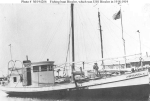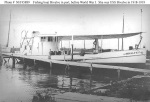| Click on thumbnail for full size image |
Size | Image Description | Source | |
|---|---|---|---|---|
| Oyster Boat Bivalve | ||||
 |
76k | Photographed prior to World War I U.S. Navy photo NH 94206 |
Naval Historical Center | |
 |
87k | In port, prior to World War I U.S. Navy photo NH 95889 |
||
| Tugboat Carrie | ||||
 |
36k | Portside view of tugboat Caddie Photo by Merritt & Chapman Derrick & Wrecking Co. |
Mystic Seaport Museum - Collections and Research Photo added 20 November 2021 |
|
(ID 2472), and used as a tender to USS Berkshire (ID 1578). No longer needed as the Navy drew down its forces after World War I, Bivalve was sold in July 1919.
| Back to the Main Photo Index | Back to the Identification Numbered Vessel (ID) Photo Index |
| Comments, Suggestions, E-mail Webmaster |
|
This page created by Joseph M. Radigan and maintained by David Wright |